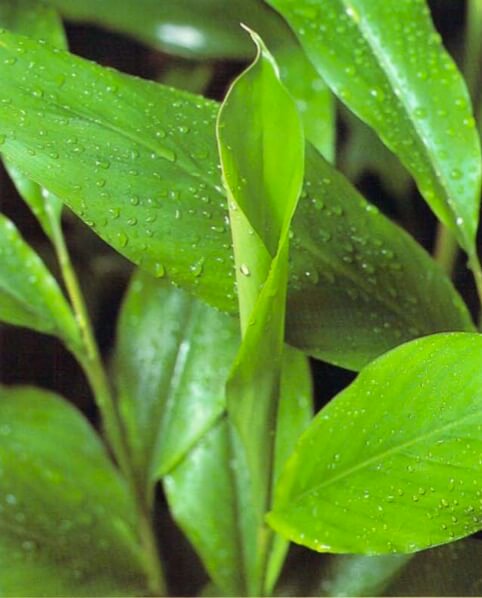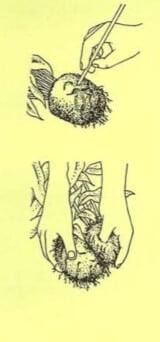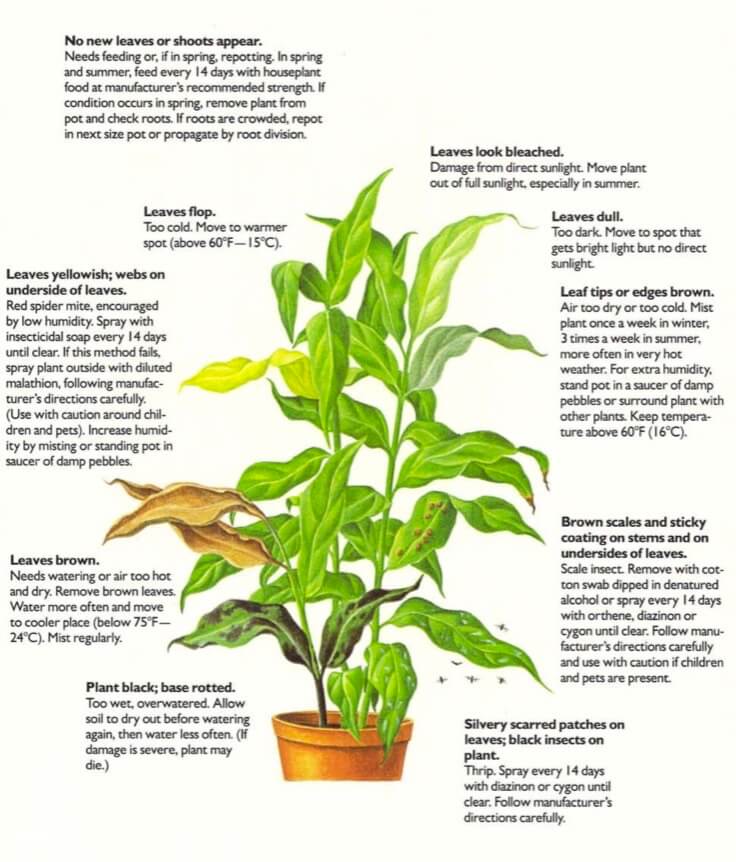[Ebook Việt Hoá] The Instant Guide to Healthy Houseplants (Hướng dẫn tức thời để chăm cây trong nhà khoẻ mạnh), Chi Elettaria - Chi Tiểu Đậu Khấu)
[Ebook Việt Hoá] The Instant Guide to Healthy Houseplants: Elettaria cardamomum (Cardamom plant)
- Nguồn: [Ebook Việt Hoá] The Instant Guide to Healthy Houseplants (Hướng dẫn tức thời để chăm cây trong nhà khoẻ mạnh)
- Biên tập: Dũng Cá Xinh
- Biên dịch: Team Codai.net
English
A member of the ginger family, the cardamom plant is grown commercially as a spice. (In its native Far East, the plant is also grown for medicinal use.) It is not commonly available for growing in the home, but it can be found in specialty houses and is grown for both its look and its fragrance. Reaching a height of about 12 inches (30 cm), the plant has bamboo-like shoots that sprout oblong leaves spaced about 1 1/2 inches (4 cm) apart. When the leaves and stems are brushed or slightly crushed, they give off an aroma suggesting cinnamon. Occasionally, the plant produces small flowers on a long shoot trailing on the soil surface.

Light
Keep out of direct sunlight, especially in summer. A window that does not face the sun is best.
Temperature
Keep temperature above a winter minimum of 60°F (16°C) and below a summer maximum of 75°F (24°C). Good ventilation is essential, especially in very hot weather.
Water
Water twice a week in summer, once every 10 days in winter. If temperature drops to or below 60°F (16°C , with hold water.
Cleaning
Humidity misting is sufficient. Leafshine may be used every 3-4 weeks.
Humidity
Mist once a week in winter, 3 times a week in summer, more often in very hot weather. Increase humidity by surrounding plant with other plants or placing pot on a tray of pebbles nearly covered with water.
Feeding
In spring and summer, feed every 14 days with houseplant food at manufacturer’s recommended strength.
Soil
Use loam-based or peat-based soil.
Repotting
Repot annually in spring when plant starts to make new growth.
Root division
- 1. In spring, if pot is over-crowded with stems, remove plant from pot and gently tease stale soil from around roots and rhizomes.
- 2. Divide plant rough ly in half by pulling apart sections of stems and roots so that each half has a fairly equal portion of rhizome and root. Repot each half.

What Goes Wrong

- No new leaves or shoots appear: Needs feeding or, if in spring, repotting. In spring and summer, feed every 14 days with houseplant food at manufacturer’s recommended strength. If condition occurs in spring, remove plant from pot and check roots. If roots are crowded, repot in next size pot or propagate by root division.
- Leaves flop: Too cold. Move to warmer spot (above 60°F-15°C).
- Leaves yellowish; webs on underside of leaves: Red spider mite, encouraged by low humidity. Spray with insecticidal soap every 14 days until clear. If this method fails, spray plant outside with diluted malathion, following manufacturer’s directions carefully. (Use with caution around children and pets). Increase humidity by misting or standing pot in saucer of damp pebbles.
- Leaves brown: Needs watering or air too hot and dry. Remove brown leaves. Water more often and move to cooler place (below 75°F – 24°C). Mist regularly.
- Plant black; base rotted: Too wet, overwatered. Allow soil to dry out before watering again, then water less often. (If damage is severe, plant may die.)
- Leaves look bleached: Damage from direct sunlight. Move plant out of full sunlight, especially in summer.
- Leaves dull: Too dark. Move to spot that gets bright light but no direct sunlight.
- Leaf tips or edges brown: Air too dry or too cold. Mist plant once a week in winter, 3 times a week in summer, more often in very hot weather. For extra humidity, stand pot in a saucer of damp pebbles or surround plant with other plants. Keep temperature above 60°F (16°C).
- Brown scales and sticky coating on stems and on undersides of leaves: Scale insect. Remove with cotton swab dipped in denatured alcohol or spray every 14 days with orthene, diazinon or cygon until clear. Follow manufacturer’s directions carefully and use with caution if children and pets are present.
- Silvery scarred patches on leaves; black insects on plant: Thrip. Spray every 14 days with diazinon or cygon until clear. Follow manufacturer’s directions carefully.
Tiếng Việt
Là một thành viên của họ gừng, cây bạch đậu khấu được trồng để thương mại hóa như một loại gia vị. (Ở vùng Viễn Đông bản địa của nó, cây này cũng được trồng để làm thuốc.) Nó không phổ biến để trồng trong nhà, nhưng vẫn có thể tìm thấy trong những ngôi nhà đặc biệt và được trồng để lấy cả vẻ đẹp và hương thơm. Đạt chiều cao khoảng 12 inch (30 cm), cây có các chồi giống như cây tre mọc ra các lá thuôn dài cách nhau khoảng 1 1/2 inch (4 cm). Khi vò nhẹ lá và thân, chúng tỏa ra mùi thơm gợi mùi quế. Đôi khi, cây tạo ra những bông hoa nhỏ trên chồi non nằm dài lên bề mặt đất trồng.

Ánh sáng
Tránh ánh nắng trực tiếp, đặc biệt là vào mùa hè. Cửa sổ không đối diện với mặt trời là tốt nhất.
Nhiệt độ
Giữ nhiệt độ mùa đông tối thiểu là 60 độ F (16 độ C) và dưới mức tối đa mùa hè là 75 độ F (24 độ C). Trong thời tiết quá nóng thông gió tốt là điều cần thiết.
Nước
Tưới nước 2 lần / tuần vào mùa hè, 10 ngày / lần vào mùa đông. Nếu nhiệt độ giảm xuống hoặc dưới 60 độ F (16 độ C), thì hợp lý.
Làm sạch
Phun sương tạo độ ẩm vừa đủ. Có thể sử dụng xịt bóng lá sau 3-4 tuần.
Độ ẩm
Phun sương mỗi tuần một lần vào mùa đông, 3 lần một tuần vào mùa hè, thường xuyên hơn khi thời tiết quá nóng. Tăng độ ẩm bằng cách trồng các cây khác xung quanh hoặc đặt chậu trên khay đá cuội gần ngập nước.
Bón phân
Vào mùa xuân và mùa hè, cứ 14 ngày một lần sử dụng phân bón hữu cơ theo khuyến cáo của nhà sản xuất.
Đất
Sử dụng đất mùn hoặc đất than bùn.
Thay chậu
Thay chậu hàng năm vào mùa xuân khi cây bắt đầu phát triển.
Phân chia gốc rễ
- 1. Vào mùa xuân, nếu chậu có quá nhiều thân cây, hãy lấy cây ra khỏi chậu và nhẹ nhàng xới đất khô xung quanh rễ và thân rễ.
- 2. Chia đôi cây bằng cách kéo các phần thân và rễ rời nhau để mỗi nửa có một phần thân và rễ tương đối bằng nhau. Thay một nửa.

Các vấn đề có thể xảy ra

- Không có lá hoặc chồi mới xuất hiện: Cần bón phân hoặc thay chậu. Vào mùa xuân và mùa hè, hãy bón phân 14 ngày một lần với phân bón hữu cơ theo khuyến cáo của nhà sản xuất. Nếu tình trạng này xảy ra vào mùa xuân, hãy lấy cây ra khỏi chậu và kiểm tra rễ. Nếu rễ mọc nhiều, thay chậu vào cỡ tiếp theo hoặc nhân giống bằng cách chia rễ.
- Nhiều lá rụng: Quá lạnh. Di chuyển đến vị trí ấm hơn (trên 60 độ F-15 độ C).
- Lá hơi vàng; mạng nhện ở mặt dưới của lá: Nhện đỏ xuất hiện bởi độ ẩm thấp. Phun xà phòng diệt côn trùng 14 ngày một lần cho đến khi khỏi bệnh. Nếu phương pháp này không thành công, hãy phun malathion pha loãng cẩn thận bên ngoài cây theo hướng dẫn của nhà sản xuất. (Thận trọng khi sử dụng xung quanh trẻ em và vật nuôi). Tăng độ ẩm bằng cách phun sương hoặc đặt chậu trong đĩa sỏi ẩm.
- Lá màu nâu: Cần tưới nước hoặc không khí quá nóng và khô. Loại bỏ lá nâu. Tưới nước thường xuyên hơn và di chuyển đến nơi mát hơn (dưới 75 độ F – 24 độ C). Phun sương thường xuyên.
- Cây bị đen; đế mục nát: Quá ẩm ướt, bị mục nát. Để đất khô trước khi tưới lại, sau đó tưới ít hơn. (Nếu thiệt hại nặng, cây có thể chết.)
- Lá bị tẩy trắng: Thiệt hại do ánh nắng trực tiếp. Di chuyển cây ra khỏi ánh sáng mặt trời đầy đủ, đặc biệt là vào mùa hè.
- Lá xỉn màu: Quá tối. Di chuyển đến chỗ có ánh sáng nhưng không có ánh nắng trực tiếp.
- Đầu hoặc mép lá màu nâu: Không khí quá khô hoặc quá lạnh. Phun sương mỗi tuần một lần vào mùa đông, 3 lần một tuần vào mùa hè, thường xuyên hơn khi thời tiết quá nóng. Để có thêm độ ẩm, đặt chậu trong một đĩa sỏi ẩm hoặc trồng các loại cây khác xung quanh. Giữ nhiệt độ trên 60 độ F (16 độ C).
- Vảy nâu, lớp phủ dính trên thân và mặt dưới lá: Sâu bọ. Loại bỏ bằng tăm bông nhúng vào cồn biến tính hoặc xịt 14 ngày một lần với orthene, diazinon hoặc cygon cho đến khi sạch. Làm theo hướng dẫn của nhà sản xuất một cách cẩn thận và sử dụng thận trọng nếu có trẻ em và vật nuôi.
- Các mảng sẹo màu bạc trên lá; côn trùng đen trên cây: Bọ cánh viền. Phun 14 ngày một lần bằng diazinon hoặc cygon cho đến khi khỏi bệnh. Làm theo hướng dẫn của nhà sản xuất một cách cẩn thận.
![[Ebook Việt Hoá] The Instant Guide to Healthy Houseplants: Elettaria cardamomum (Cardamom plant) [Ebook Việt Hoá] The Instant Guide to Healthy Houseplants: Elettaria cardamomum (Cardamom plant)](https://vn1.vdrive.vn/codai.net/2020/02/ebook-huong-dan-tuc-thoi-cham-cay-trong-nha-khoe-manh-32-elettaria-cardamaomum.jpg)


